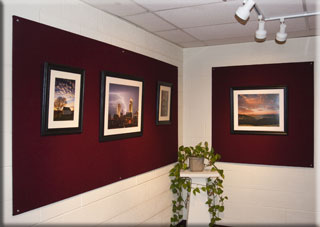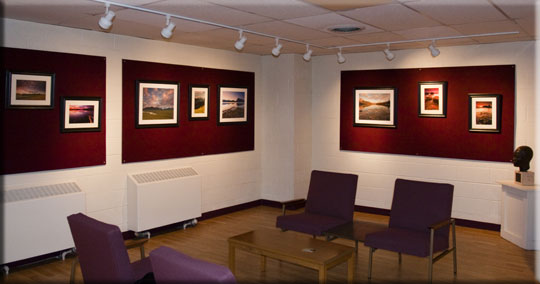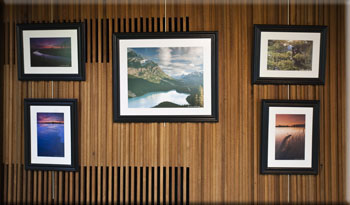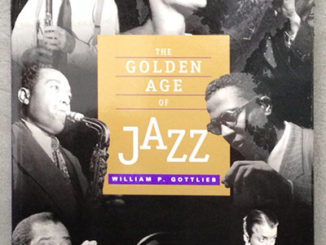
Copyright © Derrald Farnsworth-Livingston 2010
William Penn University in Oskaloosa, Iowa
There is an art to taking great photos and there is an art to developing the knowledge and skills needed to get those photos shown in a gallery setting.
Photography Gallery Ideas
In an effort to find out how to put together a photography show, I interviewed three photographers who have extensive experience in presenting their photo art in gallery shows.
What follows is some advice from Derrald Farnsworth-Livingston of Omaha, Nebraska; Larry Ferguson, also of Omaha; and Liz Darlington of Savannah, Georgia.
Step 1: Knowing the Business
Ferguson
Ferguson suggests starting with the question, “Why?”
“You have to think that you are a good enough photographer to put yourself out there and have some sort of gumption or knowledge about yourself that you think you should be an exhibiting artist,” he said. “Ask yourself, ‘Why do you even want to do that?’ It opens you up to review and critical analysis. You have to think about why you want to put your work on public display.”
He suggests accumulating resume materials and recommendations ahead of time. Become extremely knowledgeable about the industry and then have something unique that nobody else has.
For young photographers or for those new to the world of fine art photography, Ferguson suggests that they need to know who the galleries are, know about the shows being presented and the venues available. And participating in group shows is a great way to start.
“You’ve got to start somewhere,” he said. “Start where it will be easy for you to show. Look in listings in newspapers, find which galleries are approachable.”
He said people need to look at business opportunities. Some may be able to do a show at a local library or hallway gallery.
“Most young people or new artists need to start out small,” he said. “Getting someone into a group show would be beneficial.”
“There is a hierarchy–a pecking order,” he said. “It takes an incredible amount of work, skill and personality to make it all come together.”
Step 2: Finding a Location
Darlington
“Get to know the gallery curators and their staff. Then attend their openings and approach them with each new body of work to see if they are interested in showing it,” she said. “You can also rent gallery space in most towns and put together your own show that way. Be sure to do a press release and invite as many gallery owners/curators as possible to your show.”
Farnsworth-Livingston
If one does not have their own studio, Farnsworth-Livingston suggests doing a bit of homework–find out where other artists have been exhibiting photographs. It may take time, but it can be well worth it.
“Since I do not have my own studio, I often research where area artists have been exhibiting. Once those galleries have been found, there are usually contacts available via a website,” he said. “And sometimes, I have to email several people in order to get to the correct individual.”
Ferguson
Ferguson, who has participated in over 400 exhibitions and worked as a photographer for over 30 years, also suggests matching the caliber of the gallery in which you wish to present.
“When you approach galleries, you have to make sure your work fits into their scenario,” he said. “You don’t want to try to exhibit out of your league. Be sure your photographic art meets their standards of quality–the quality of existing artists being handled,” he said.
Step 3: Selection of Photographs
Farnsworth-Livingston
“The first thing I do to prepare for a show is to select the pieces which will be exhibited,” he said. “I spend several days going through a selection process.”
“I start with about 70 images and then slowly whittle that down to the final selections,” he added. “I then have those pieces printed with about 5 extra in case an image does not turn out how I had envisaged for the final show.”
Darlington
“Making a start on the work so you can pitch the idea to a gallery is probably the most important thing,” she said. “I always like to have three or four images from the series complete and I will then send them to galleries as part of a proposal for a show.”
Ferguson
Ferguson said it is important to have a tight body of work and that can take time. And once the photos are selected, presentation is also a key.
“Go into a presentation with photographs professionally matted, framed and ready to go,” Ferguson said. “There must be flawless execution in putting it all together.”
Step 4: Printing and Framing
Farnsworth-Livingston
When you consider the size of the prints, Farnsworth-Livingston said that will vary from exhibit to exhibit. He uses a variety of sizes ranging from 8×12 inches, which is matted and framed to 14×18 inches, to 20×30 inches, which is matted and framed to 28×38 inches.
Not distracting from the photograph itself, Farnsworth-Livingston said he uses a consistent medium for prints.
“All the pieces are printed on glossy photographic stock and framed,” he said. “I use a consistent, simple frame with the same color mat so that the framing does not distract from the art.”

Copyright © Derrald Farnsworth-Livingston 2010
William Penn University in Oskaloosa, Iowa
Darlington
“Galleries often want the work as large as they can possibly be, unless you have a conceptual reason for working smaller,” she said. “I always enlarge as much as possible, but if this isn’t in keeping with how you want the work to be, it is not necessary. Many artists want the viewers to have a more intimate experience with the work, so they choose to print smaller.”
Darlington said she works in two print mediums for her work.
“The first is acetate or transparency. I then sandwich the prints between two pieces of glass so there is almost a lightbox luminescence to the image,” she said. “More recently I have been printing on Fujiflex paper and then front mounting piece to plexiglass for a borderless professional print quality.”
“The reason a particular print medium is chosen is usually dependent on the type of work you are doing,” she added.
Step 4: Knowing Your Costs and Gallery Participation in Those Costs
Prepare yourself–your cost could vary depending upon the size of the show, your abilities to do some of your own work, your location, the number of pieces being printed and framed, the size of each piece and the materials used.
And in addition, there will be fees paid to the galleries. Our photographers told me that the galleries commissions can vary widely. They will take anywhere from nothing, which is rare, to a small fee, up to 30% and 50% of the retail price.

Copyright © Derrald Farnsworth-Livingston 2010
DeSoto National Wildlife Refuge near Missouri Valley, Iowa
Farnsworth-Livingston
“The typical costs for different sizes, which include the print, mats and frame are approximately:
$60 for an 8×12 inch photo, $100 for a 12×18 inch photo and $120 for a 16×20 inch photo.”
Gallery Participation: “Shows almost never cover the costs. The exposure does bring some recognition and can bring in sales later. It usually takes several years of repeat shows for a gallery to participate in your costs.”
Darlington
“The costs can depend on many things, including whether or not you are able to do your own printing, how large the work is, and whether or not you pay someone to frame the work. On average, I pay around $150-250 per image to have it printed and framed professionally. Therefore the average cost for a show that includes 10 images is around $1500-2500 and this excludes shipping or delivery costs associated with getting the work the gallery.”
Gallery Participation: “I usually try to get grants to pay for the show, otherwise everything is out of pocket in the hope that I recoup costs through sales. I very rarely make money on a show. Most people I know are happy if they manage to cover costs, although some are lucky enough to actually make a little profit.”
Ferguson
“The cost–it depends upon how big of a show you and the gallery want to put on,” he said. “The number of pieces and the size of those artworks can vary widely. The bigger you are in the art world, the bigger your shows might be and the scale of the works may be bigger too.”
“Smaller works may have a materials investment of $50 each and bigger works may have a materials investment of $1,000 each. That’s with me doing all of the work myself, including all the darkroom work and the matting and framing. My last big show cost me over $15,000 in materials.”
Gallery Participati0n: “Galleries are in the business of selling art, so if your work doesn’t sell, there won’t be any more shows of your work at that venue. Later, how are you going to share the profits of photo shoots that happen after a gallery show with the gallery if they helped promote your show? If you are showing your work in like a library or some other public venue that doesn’t get a lot of sales, then you will have to think about how you are going to make money doing that.”
“Sometimes you just want to have a show to get some credentials, sometimes that’s the only way to get a real gallery to actually take on your work and show/sell it. You have to start somewhere. And my personal experience is that once the exhibit has closed at a particular venue, there are usually very few phone calls from people who want to buy your work outside of that venue. If people do want to get in tough, they will usually call the gallery and not the artist.”
Added Information…
You’re set up with a show, so what more do you need to know.
How Long Do Exhibits Last?
Farnsworth-Livingston
“Typically, an exhibit lasts for about a month.”
Ferguson
“Exhibition lengths can vary from gallery to gallery. Sometimes shows can last a few days or a few months, depending upon the venue. Typically shows run from three to four weeks. It’s all about what you and the gallery can agree to do together.”
Darlington
“Usually they show the work anywhere from one week to one month, depending on the type of space. Most commercial galleries show for at least a month.”
Setting Up the Exhibit: What You’ll Need to do Before Opening Day
Farnsworth -Livingston
“You need to have an idea of what order the prints will be in. You need to take and make sure that any presentation materials always are available. Things like brochures or display cards with your name and information may be required.”
Ferguson
“Promotion of the exhibition… You have to get the word out about the show so that people can come to it–newspapers, FaceBook, emails, sending out promo packets to news outlets and reporters, along with printable files for publications. Call family and friends and invite them to come.”
Darlington
“Postcards are made and sent out as invites, as well as e-cards and press releases.”
“The finished work is delivered to the gallery usually a few days before or on the actual day of hanging.”
“There is usually an opening night reception and in some cases, people include a closing reception.”
So if you’re ready to put yourself out there, take your newly gained knowledge and venture out into the world of photo gallery exhibitions.
by Elizabeth Elliott




Leave a Reply